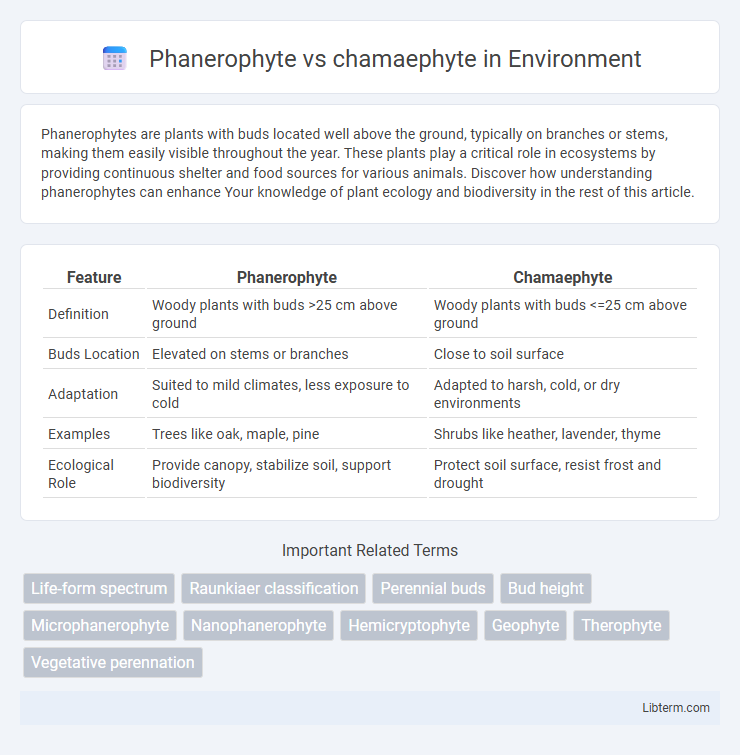Phanerophytes are plants with buds located well above the ground, typically on branches or stems, making them easily visible throughout the year. These plants play a critical role in ecosystems by providing continuous shelter and food sources for various animals. Discover how understanding phanerophytes can enhance Your knowledge of plant ecology and biodiversity in the rest of this article.
Table of Comparison
| Feature | Phanerophyte | Chamaephyte |
|---|---|---|
| Definition | Woody plants with buds >25 cm above ground | Woody plants with buds <=25 cm above ground |
| Buds Location | Elevated on stems or branches | Close to soil surface |
| Adaptation | Suited to mild climates, less exposure to cold | Adapted to harsh, cold, or dry environments |
| Examples | Trees like oak, maple, pine | Shrubs like heather, lavender, thyme |
| Ecological Role | Provide canopy, stabilize soil, support biodiversity | Protect soil surface, resist frost and drought |
Introduction to Plant Life Forms
Phanerophytes are perennial plants characterized by their buds located well above the ground, typically on stems or branches, allowing them to thrive in environments with minimal disturbances. Chamaephytes have buds close to the soil surface, usually within 25 cm, providing protection against harsh weather and grazing, making them common in alpine and arid regions. Both growth forms are essential components in Raunkiaer's life form classification, reflecting adaptive strategies to environmental conditions.
Defining Phanerophytes
Phanerophytes are perennial plants characterized by their buds located more than 25 cm above the soil surface, enabling them to withstand exposure and varying climatic conditions. These plants include trees and shrubs with well-developed woody stems that support leaves and reproductive structures year-round. In contrast, chamaephytes have buds situated close to the ground, typically within 25 cm, offering better protection from harsh environments but limiting their vertical growth.
Understanding Chamaephytes
Chamaephytes are perennial plants with buds located close to the ground, typically less than 25 cm above the soil surface, which enhances their survival in harsh climates and frequent disturbances. Unlike phanerophytes, which have buds on shoots at considerable height, chamaephytes exhibit a low stature that protects their regenerative tissues from extreme cold, wind, and herbivory. This growth form is common in alpine, arctic, and desert ecosystems where environmental stressors limit the vertical development of vegetation.
Key Differences Between Phanerophytes and Chamaephytes
Phanerophytes have their perennating buds located more than 25 cm above the soil surface, typically on trees and tall shrubs, whereas chamaephytes bear buds close to the ground, within 25 cm, often found in low-growing shrubs and herbs. Phanerophytes are adapted to stable environments with taller structures for light access, while chamaephytes are suited for harsher climates, protecting buds from extreme weather by staying close to the soil. The differences in bud positioning influence their ecological roles, growth patterns, and survival strategies in various habitats.
Ecological Roles of Phanerophytes
Phanerophytes play a crucial ecological role as primary producers in terrestrial ecosystems, providing habitat and food for numerous animal species. Their tall, woody structures contribute to carbon sequestration and help stabilize soil, reducing erosion. By forming forest canopies, phanerophytes regulate microclimates and support biodiversity, contrasting with chamaephytes that typically occupy lower, more exposed niches.
Ecological Significance of Chamaephytes
Chamaephytes, characterized by perennating buds close to the ground, play a crucial role in stabilizing soil and preventing erosion in harsh environments such as alpine and arid regions. Their low stature and adaptability to extreme climatic conditions enhance biodiversity by providing microhabitats and food sources for various fauna. Unlike phanerophytes, which grow taller and require more resources, chamaephytes efficiently conserve water and nutrients, promoting ecosystem resilience.
Adaptations for Survival
Phanerophytes survive harsh climates by developing tall woody stems that elevate their buds above ground level, protecting them from frost and herbivores, while chamaephytes adapt by keeping their buds close to the soil surface, often insulated by leaf litter or snow. These structural differences enhance their ability to withstand environmental stresses such as temperature fluctuations and physical damage. Phanerophyte adaptations are particularly advantageous in temperate forests, whereas chamaephytes thrive in alpine and arid regions with extreme conditions.
Distribution and Habitat Preferences
Phanerophytes predominantly occur in tropical and temperate regions where they thrive in diverse habitats ranging from rainforests to savannas, favoring environments with sufficient moisture and stable conditions for their tall woody structures. Chamaephytes are commonly found in arid, alpine, and cold regions, adapted to survive harsh climates by growing close to the ground, which reduces exposure to wind and frost. Their distribution reflects ecological strategies to maximize survival, with phanerophytes dominating stable, resource-rich environments and chamaephytes prevailing in exposed, resource-scarce habitats.
Examples of Phanerophyte and Chamaephyte Species
Phanerophytes include tall trees and large shrubs such as oak (Quercus spp.), eucalyptus (Eucalyptus spp.), and coconut palm (Cocos nucifera), which have their perennating buds located well above the ground. Chamaephytes comprise smaller plants and low shrubs like heather (Calluna vulgaris), thyme (Thymus spp.), and lavender (Lavandula spp.), with buds positioned close to or just above the soil surface. These distinctions in bud placement reflect adaptations to different environmental conditions and play a key role in the Raunkiaer life-form classification system.
Importance in Plant Ecology and Biodiversity
Phanerophytes, with their prominent above-ground woody stems, play a crucial role in stabilizing ecosystems by providing habitat and food sources for diverse animal species, enhancing biodiversity and ecological resilience. Chamaephytes, characterized by their low-lying woody structures, contribute to ecological balance by thriving in harsh climates and poor soils, aiding in soil stabilization and microhabitat formation. Understanding the distribution and adaptations of phanerophytes and chamaephytes is essential for conservation efforts and maintaining ecosystem functions in varying environmental conditions.
Phanerophyte Infographic

 libterm.com
libterm.com